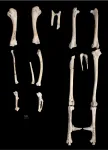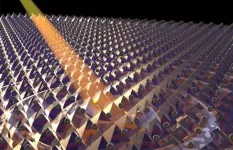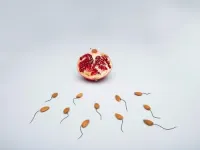(Press-News.org) An international team of scientists led from the Centre for Astrobiology (CAB, CSIC-INTA), with participation from the Instituto de Astrofísica de Canarias (IAC), has used the Gran Telescopio Canarias (GTC) to study a representative sample of galaxies, both disc and spheroidal, in a deep sky zone in the constellation of the Great Bear to characterize the properties of the stellar populations of galactic bulges. The researchers have been able to determine the mode of formation and development of these galactic structures. The results of this study were recently published in The Astrophysical Journal.
The researchers focused their study on massive disc and spheroidal galaxies, using imaging data from the Hubble Space Telescope and spectroscopic data from the SHARDS (Survey for High-z Absorption Red and Dead Sources) project, a programme of observations over the complete GOODS-N (Great Observatories Origins Deep Survey - North) region through 25 different filters taken with the OSIRIS instrument on the Gran Telescopio Canarias (GTC), the largest optical and infrared telescope in the world, at the Roque de los Muchachos Observatory (Garafía, La Palma, Canary Islands).
Analysis of the data allowed the researchers to discover something unexpected: the bulges of the disc galaxies were formed in two waves. One third of the bulges in disc galaxies were formed at redshift 6.2, which corresponds to an early epoch in the Universe, when it was only 5% of its present age, around 900 million years old. "These bulges are the relics of the first structures formed in the Universe, which we have found hidden in local disc galaxies", explains Luca Costantin, a researcher at the CAB within a programme of Attracting Talent of the Community of Madrid, and the first author on the paper.
But in contrast, almost two thirds of the bulges observed show a mean value of redshift of around 1.3, which means that they were formed much more recently, corresponding to an age of four thousand million years, or almost 35% of the age of the Universe.
A peculiar characteristic which permits the distinction between the two waves is that the central bulges of the first wave, the older bulges, are more compact and dense than those formed in the second, more recent wave. In addition, the data from the spheroidal galaxies in the sample show a mean redshift value of 1.1, which suggests that they formed in the same general time as the bulges of the second wave.
For Jairo Méndez Abreu, a researcher at the University of Granada (UGR) and a co-author of the article, who was formerly a Severo Ochoa postdoctoral researcher at the IAC, "the idea behind the technique used to observe the stars in the central bulge is fairly simple, but it has not been possible to apply it until the recent development of methods which have allowed us to separate the light from the stars in the central bulge from those in the disc, to be specific the GASP2D and C2D algorithms, which we have developed recently and which have enabled us to achieve unprecedented accuracy".
Another important result of the study is that the two waves of bulge formation differ not only in terms of the ages of their stars, but also in terms of their star formation rates. The data indicate that the stars in the bulges of the first wave formed quickly, on timescales of typically 200 million year. On the contrary, a significant fraction of the stars in the bulges of the second wave required formation times five times longer, some thousand million years.
"We have found that the Universe has two ways of forming the central zones of galaxies like our own: starting early and performing very quickly, or taking time to start, but finally forming a large number of stars in what we know as the bulge", comments Pablo G. Pérez González, a researcher at the CAB, and Principal Investigator of the SHARDS project, which gave essential data for this study. In the words of Antonio Cabrera, the Head of Science Operations at the GTC, "SHARDS is a perfect example of what is possible due to the combination of the huge collecting capacity of the GTC and the extraordinary conditions at the Roque de los Muchachos Observatory, to produce 180 hours of data with such excellent image quality, essential for the detection of the objects analysed here".
As described by Paola Dimauro, a researcher at the National Observatory of Brazil and a co-author of this article, "this study has allowed us to explore the morphological evolution and the history of the assembly of the structural components of the galaxies, analagous to archaeological studies, analysing the information encoded in the millions of stars of each galaxy. The interesting point was to find that not all the structures were formed at the same time, or in the same way".
The results of this study have allowed the observers to establish a curious parallel between the formation and the evolution through time of the disc galaxies studies and the creation and development of a large city during the centuries. Just as we find that some large cities have historic centres, which are older and house the oldest buildings in cluttered narrow streets, the results of this work suggest that some of the centres of massive disc galaxies harbour some of the oldest spheroids formed in the Universe, which have continued to acquire material, forming discs more slowly, the new city outskirts in our analogy.
INFORMATION:
The Gran Telescopio Canarias and the Observatories of the Instituto de Astrofísica de Canarias (IAC) form part of the network of Singular Scientific and Technical Infrastructures (ICTS) of Spain.
Article: Luca Costantin, Pablo G. Pérez-González, Jairo Méndez-Abreu, Marc Huertas-Company, Paola Dimauro, et al. "A duality in the origin of bulges and spheroidal galaxies". The Astrophysical Journal. DOI: https://doi.org/10.3847/1538-4357/abef72
- Arxiv: https://arxiv.org/abs/2103.10438
Bad sleep causes severe health issues and affects our ability to concentrate, memorize, and cope with challenging situations. Individuals with neurodevelopmental disorders such as autism and intellectual disability, frequently suffer from sleep problems. However, little is known about their underlying mechanisms. In Science Advances, a Dutch-American research team, coordinated by Radboudumc, now describes how these problems can arise. Mimicking two genetic causes of autism in fruit flies, they uncovered that flies show the same sleep problems as the patients, and that the disturbed ...
Ancient chickens lived significantly longer than their modern equivalents because they were seen as sacred - not food - archaeologists have found.
Experts have developed the first reliable method of finding the age of fowl who lived thousands of years ago. Their research shows they lived to advanced ages, and were kept for ritual sacrifice or cockfighting rather than meat or egg production.
Chickens today live for a few weeks (in the UK poultry birds live for between 33 and 81 days), but during the Iron Age, Roman and Saxon period they lived up to the age of two, three or even four years old.
Calculating ...
On Friday, 11 June, Europe's men's football teams will start the European Championship a year later than planned. The favourite this time is France with a probability of winning of 14.8 per cent. This is what an international team of researchers consisting of Andreas Groll and Franziska Popp (both TU Dortmund, Germany), Gunther Schauberger (TU Munich, Germany), Christophe Ley and Hans Van Eetvelde (both Ghent University, Belgium), Achim Zeileis (University of Innsbruck, Austria) and Lars Hvattum (Molde University College, Norway) has shown with the help of machine learning. Their forecast combines several statistical models for ...
For years, psychology researchers have treated peer rejection and social network isolation as being somewhat interchangeable when it comes to early adolescence; it was thought that if kids fell into one of those two groups, they fell into the other. A recent study finds there is actually little overlap between the groups - and socially isolated kids face different risks.
"Broadly speaking, there are two types of socially marginalized groups in early adolescence," says Kate Norwalk, lead author of the study and an assistant professor of psychology at North Carolina State University. "There are kids who face peer rejection, meaning they are disliked by other kids; and there are kids who are experiencing social network isolation, meaning they don't have a ...
Many contemporary political conflicts are between those who would prioritize the needs of local or national communities and those with a more universal outlook. According to a new study by IASS researcher Silvia Weko, this split between "communitarian" and "cosmopolitan" Europeans is also evident in their attitudes towards European climate policy. Achieving climate neutrality without exacerbating societal divisions within and between countries will require the EU to strike a careful balance.
In political philosophy cosmopolitans and communitarians are frequently characterized as "winners" and "losers" of globalization. ...
UPTON, NY--What happens when very short pulses of laser light strike a magnetic material? A large international collaboration led by the U.S. Department of Energy's (DOE) Brookhaven National Laboratory set out to answer this very question. As they just reported in the Proceedings of the National Academy of Sciences, the laser suppressed magnetic order across the entire material for several picoseconds, or trillionths of a second. Understanding how magnetic correlations change on ultrafast timescales is the first step in being able to control magnetism in application-oriented ways. For example, with such control, we may be able to more quickly write data to memory devices or enhance superconductivity ...
The lack of data is a major bottleneck for many kinds of research, and especially for the development of better medical treatments and drugs. This data is extremely sensitive and, understandably, people and companies alike are often unwilling to share their information with others.
Researchers at the Finnish Center for Artificial Intelligence have developed a machine learning-based method that produces synthetic data on the basis of original data sets, making it possible for researchers to share their data with one other. This could solve the ongoing problem of data scarcity in medical research and other fields where information is sensitive.
The generated data preserves privacy, remaining similar enough to the original data to be used for statistical ...
Researchers at Queen Mary University of London have tested an algorithm on 700,000 patient records in east London, to find out if the data routinely collected by GPs can reveal cases of Familial Hypercholesterolemia - a leading cause of heart attack in young people.
Familial Hypercholesterolemia (FH) is a condition passed down through families that causes extremely high levels of cholesterol in the blood. Without treatment, it can lead to a heart attack at a very young age. FH affects 320,000 people in the UK, the vast majority of whom are unaware they have it.
One method of detection is the 'FAMCAT' (Familial Hypercholesterolemia Case Assertation Tool) which analyses data in GP records - including ...
The ability of stem cells to fix impaired functions of host tissues after transplantation has been a lifesaving breakthrough in treating previously incurable conditions. Much like a coin toss, however, the fate of the transplanted stem cells is unpredictable. They may choose self-renewal, grow into a different kind of tissue, or die.
Spermatogonial stem cells follow the same stochastic fate of unpredictability in outcomes. But a group of fertility scientists led by Hiroshima University's Yoshiaki Nakamura discovered a new method that has favorably flipped the odds and successfully reversed male infertility in mice -- showing great promise for future applications in regenerating human sperm after cancer treatment ...
Normally, the ACE2 enzyme helps regulate our blood pressure. The enzyme sits on the surface of cells, including cells in the lungs, but in connection with COVID-19 it has been found that ACE2 also functions as a gateway for the virus.
"Different viruses have different ways of accessing our cells - as the virus must, of course, get into the cell to be able to replicate, and the coronavirus uses ACE2 to gain access. For this reason, we're investigating what the concentration of ACE2 means for the course of the disease, if you get COVID-19," explains MD and PhD Tue Wenzel Kragstrup from the Department of Biomedicine at Aarhus University. The preliminary results have just been published in the scientific journal PLOS ONE.
As mentioned, ACE2 is part of the surface of the cells, but ...



